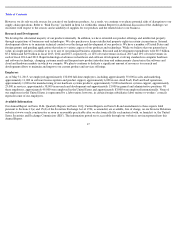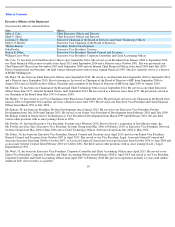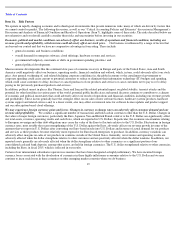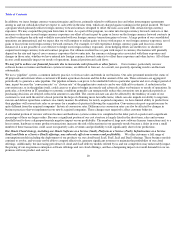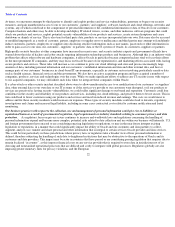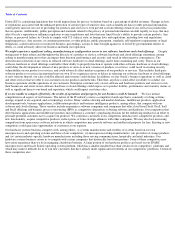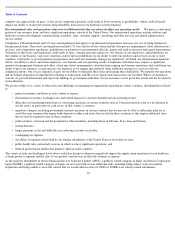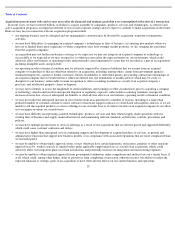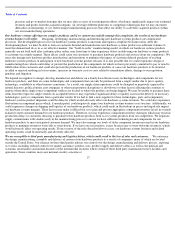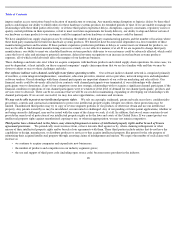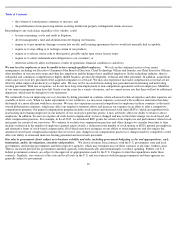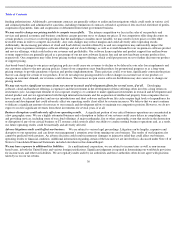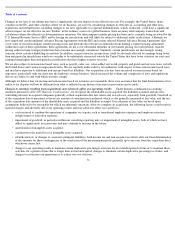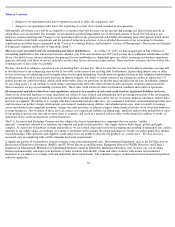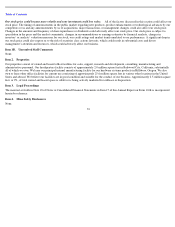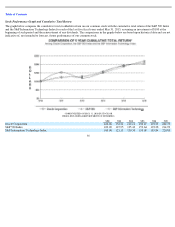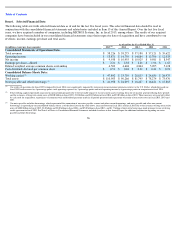Oracle 2014 Annual Report Download - page 30
Download and view the complete annual report
Please find page 30 of the 2014 Oracle annual report below. You can navigate through the pages in the report by either clicking on the pages listed below, or by using the keyword search tool below to find specific information within the annual report.
Table of Contents
The occurrence of any of these risks could have a material adverse effect on our business, results of operations, financial condition or cash flows,
particularly in the case of a larger acquisition or several concurrent acquisitions.
Our periodic workforce restructurings, including reorganizations of our sales force, can be disruptive. We have in the past restructured or
made other adjustments to our workforce, including our direct sales force on which we rely heavily, in response to management changes, product
changes, performance issues, acquisitions and other internal and external considerations. In the past, these types of sales force restructurings
have resulted in increased restructuring costs, increased sales and marketing costs and temporary reduced productivity while the sales teams
adjusted to their new roles and responsibilities. In addition, we may not achieve or sustain the expected growth or cost savings benefits of these
restructurings, or do so within the expected timeframe. These effects could recur in connection with future acquisitions and other restructurings
and our revenues and other results of operations could be negatively affected.
Our hardware systems revenues and profitability could decline if we do not manage the risks associated with our hardware systems business.
Our hardware systems business may adversely affect our overall profitability if we do not effectively manage the associated risks. We may not
achieve our estimated revenue, profit or other financial projections with respect to our hardware systems business in a timely manner or at all
due to a number of factors, including:
26
•
our use of cash to pay for acquisitions may limit other potential uses of our cash, including stock repurchases, dividend payments and
retirement of outstanding indebtedness;
•
we may significantly increase our interest expense, leverage and debt service requirements if we incur additional debt to pay for an
acquisition and we may have to delay or not proceed with a substantial acquisition if we cannot obtain the necessary funding to
complete the acquisition in a timely manner or on favorable terms;
•
to the extent that we issue a significant amount of equity securities in connection with future acquisitions, existing stockholders may be
diluted and earnings per share may decrease; and
•
we may experience additional or unexpected changes in how we are required to account for our acquisitions pursuant to U.S. generally
accepted accounting principles, including arrangements that we assume from an acquisition.
•
as we develop and introduce new versions or next generations of our hardware systems products, customers may defer or delay
purchases of existing hardware systems products and wait for these new releases, all of which could adversely affect our hardware
systems revenues in the short term;
•
our hardware systems business has higher expenses as a percentage of revenues, and thus has been less profitable, than our software and
cloud business;
•
we have focused on our more profitable Oracle Engineered Systems, such as our Oracle Exadata Database Machine, Oracle Exalogic
Elastic Cloud, Oracle Exalytics In-Memory Machine and Oracle SuperCluster products, which are in the relatively early stages of
adoption by our customers, and the de-emphasis of our lower profit margin commodity hardware systems products could adversely
affect our hardware systems revenues because the lower profit systems have historically constituted a larger portion of our hardware
systems revenues;
•
we face a greater risk of potential write-downs and impairments of inventory, higher warranty expenses than in our software and cloud
and services businesses, and amortization and potential impairment of intangible assets associated with our hardware systems business.
Any of these items could result in material charges and adversely affect our operating results;
•
we may not be able to increase sales of hardware systems support contracts or such increase may take longer than we anticipate, which
could result in lower revenues and profitability, or slower than expected growth of such revenues and profitability; and
•
we may acquire hardware companies that are strategically important to us but (i) operate in hardware businesses with historically lower
operating margins than our own; (ii) have different legacy business



